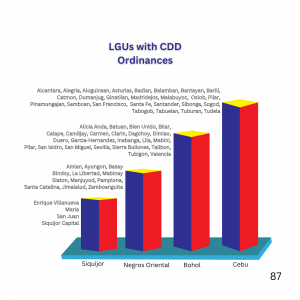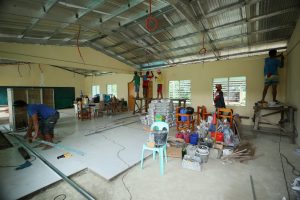With a 20-year legacy, the Kapit-Bisig Laban sa Kahirapan–Comprehensive and Integrated Delivery of Social Services (KALAHI-CIDSS) program is notable for its signature Community-Driven Development (CDD) approach, which empowers communities to drive their own development.

In Central Visayas, the Regional Program Management Office, went beyond merely completing subprojects; it ensured that CDD became an integral part of local governance.
Such support for the CDD approach materialized by the passing of CDD ordinances by 66 local government units (26 from Cebu, 24 from Bohol, 12 from Negros Oriental, and four from Siquijor) in the region.
The concepts of “participatory planning, capacity building, control of funds, and transparency and accountability” have been deeply ingrained in the community that even if KALAHI-CIDSS ends or transitions into a new project, its CDD spirit will continue to live on in the community.
Among the LGUs in Bohol that passed resolutions supporting CDD are Garcia-Hernandez, Alicia, Anda, and Guindulman.
In a video interview with KALAHI-CIDSS, Garcia-Hernandez Mayor Engr. Filadelfo Jess Baja III said the CDD approach empowered his constituents by showing them they can contribute to their community even without professional jobs or higher education.
Women’s participation in KALAHI-CIDSS has also been instrumental, with many taking active roles in decision-making, project implementation, and community leadership.
In Central Visayas, 29 municipalities from Cebu and Bohol (comprising 259 barangays) committed to the implementation of NCDDP Phase 3, with 294 subprojects endorsed.
“Ang impact sa CDD approach, very helpful jud siya kaayo. Swak pod siya sa felt needs sa barangay. Ang mga tawo sa barangay gi-engaged g’yud. Sila tanan ang ni-trabaho ug sila tanan ang mogamit sa priority projects nga gibuhat (The impact of the CDD approach has been very significant. It truly addresses the felt needs of the barangay. The people in the barangay were genuinely engaged—they all worked on the projects and are the ones who will benefit from the implemented priority projects),” he said.
Garcia-Hernandez has been a recipient of several subprojects, including a classroom in Barangay Abijilan.
Likewise, Guindulman Mayor Albino Balo said he supports CDD, saying “Ako niangay ko tungod didto jud nagpatawag og assembly sa barangay para makuha ang pinaka importante nga angay unahon (I support the CDD because the barangay held an assembly to identify and prioritize the most important needs),” he said in an interview with KALAHI-CIDSS.

A 2023 study by R.T. Lakibul revealed that the region achieved a high level of institutionalizing the CDD approach within its target municipalities.
It indicates that the principles of participation, empowerment, and transparency are inherent in the governance structures of LGUs rather than being superficial practices.
Two key factors working in tandem contributed to this achievement:
- project staff who provided timely and strategic technical assistance and
- proactive LGUs that embraced CDD by integrating its principles into their local policies and planning.
This dedication culminated in the adoption of resolutions and ordinances that formally embedded CDD principles and supported LGU-led implementation of sub-projects, known as “Phase 3” of KALAHI-CIDSS NCDDP Additional Financing (AF).
During this phase, municipalities assumed full ownership, financing development projects through their resources—demonstrating that CDD is more than just a project; it is a lasting movement rooted in empowered communities. ###